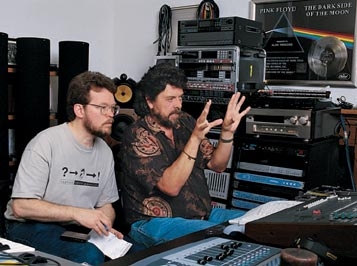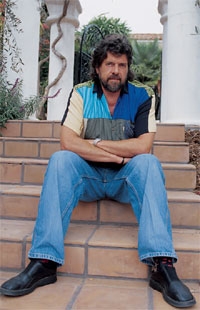Another Phase of the Moon Page 2
 Author Ken Richardson (left) listens raptly as Alan Parsons describes how he'd have shaped the sound field in The Dark Side of the Moon's multichannel remix. Even though Parsons and his fiancée, Lisa Marie Griffiths, are to be married in only ten days, he takes the time to conduct a moment-by-moment listening session. He goes beyond A/B comparisons to A/B/C comparisons: the original stereo mix, his quad mix, and Guthrie's six-channel mix. Parsons and I are in his studio, surrounded by B&W Nautilus 802 speakers. And since Track 1 of Dark Side was named after the line that he would say when testing a microphone, I just couldn't resist following suit: "Alan Parsons: speak to me." His reply: "Any colour you like!"
Author Ken Richardson (left) listens raptly as Alan Parsons describes how he'd have shaped the sound field in The Dark Side of the Moon's multichannel remix. Even though Parsons and his fiancée, Lisa Marie Griffiths, are to be married in only ten days, he takes the time to conduct a moment-by-moment listening session. He goes beyond A/B comparisons to A/B/C comparisons: the original stereo mix, his quad mix, and Guthrie's six-channel mix. Parsons and I are in his studio, surrounded by B&W Nautilus 802 speakers. And since Track 1 of Dark Side was named after the line that he would say when testing a microphone, I just couldn't resist following suit: "Alan Parsons: speak to me." His reply: "Any colour you like!" Speak to Me. "In the stereo mix, I put the heartbeat coming slightly from the right, because if a person is facing you, the heart is on the right. James has the heart dead-center."
Breathe. "I like James's placement in the beginning more than my quad mix. It works really well. But I find the vocal sound to be harsh."
On the Run. "In the stereo mix, at the beginning, I took the organ swirl and opened up the panning gradually, wider and wider. In the quad, the swirl goes right 'round the room. In James's mix, it doesn't open up at all. "After hearing his mix for a while, I think I'm hearing stereo with a bit of surround."
Time. "In James's mix, the rototoms are underfeatured, too mixed in, not jumping out at you enough. He's made more of a feature of the big bass notes. "In the main section, James's mix is nice and balanced, but the placement is only a little better than stereo. Still, he has improved the drum sound here, no question."
The Great Gig in the Sky. "I tip my hat to James for sorting out the correct bits of Clare's vocals. And he has improved on the stereo mix, which is a bit wishy-washy. The stereo is heavy on the Hammond organ, and Clare's a little too far down. In my quad mix, the Hammond is barely there, which shows you I really wasn't being faithful to the stereo mix. The quad sounds pretty good, but James still has the edge. His mix is definitely cleaner, and he's brought Clare out a bit more."
Money. "I mostly like James's placements in the surround mix. But what he's done with the sound-effects loop is very illogical. You have to wait a long time for something to appear in the left front channel. In the quad, the pattern goes around the room in a circle, starting again in the left front each seven beats. If I'd done the surround mix, I would've made the loop continue around the room the whole time, so that the circle itself would actually rotate. "Listen closely when the loop re-enters later in the song. In both the stereo mix and the quad, the timing wasn't exactly in sync with the music. James has corrected that for his mix. It was something I was dying to do for 30 years. "I went crazy with the third guitar solo in my quad mix. Thirty years later, I wish I hadn't. It's going all around the room. Very 1970s-just like the early days of stereo."
Us and Them. "I think it was the right choice in my quad mix to make the vocal echo go around the room in a circle. James has a better balance, but I'm disappointed with his vocal echo placement. "For the album, I pretty much decided when the echoes should be there and when they should not be there. . . . They're on the word 'with,' but they're not on 'without.' And when it comes to 'what the fighting's all about,' I just echoed 'bout, bout, bout, bout'-because 'bout' means 'fight.' But James missed that: he's got 'about, about, about, about.' "James's choruses are just a touch on the cluttered side. Everything is on the same level. In the stereo, they hit you harder [Parsons thrusts his fists out in front of him]: 'Forward, he cried!' "
Any Colour You Like. "On the downbeat every four bars [starting at 1:46], there's a bass-synth note that's totally missing from James's mix."
Brain Damage. "In the quad mix, the guitar picking is in the rear. This is definitely surround. And you can hear every note the girls sing. Even in the stereo mix, you don't get that. James is basically stereo with the voices forward."
Eclipse. "In James's mix, the closing heartbeat actually sounds like what it is: a kick drum. It's clean as a whistle, but I think there was a certain amount of mystique about it before."  If there's any mystery about what Parsons can achieve in a contemporary multichannel mix, it's dispelled by what he calls "my first modern-age attempt at surround": On Air, his 1996 album as remixed for an acclaimed DTS 5.1 CD. Eventually, he hopes to license the surround rights to the rest of his back catalog from Arista.
If there's any mystery about what Parsons can achieve in a contemporary multichannel mix, it's dispelled by what he calls "my first modern-age attempt at surround": On Air, his 1996 album as remixed for an acclaimed DTS 5.1 CD. Eventually, he hopes to license the surround rights to the rest of his back catalog from Arista.
Meanwhile, after his wedding and honeymoon, he plans to finish work on a new album, scheduled to be released in January on DVD-Audio by the Myutopia label of the 5.1 Entertainment Group. Assisted by his 26-year-old son, Jeremy, Parsons has fully embraced electronica. "The album is essentially a more computerized slant on what I've done in the past, with less vocals. I'm making no pretense: I'm trying to capture a younger, more clubby audience."
It's no wonder that Parsons, having gone to the Moon and back, still keeps his eyes on the sky and his ears on the cutting edge. After all, this is the man who, way back in 1975, predicted the future when he saw the Ken Russell film of Tommy and wrote about its use of "a quintophonic system-doubtless an indication of things to come." Forward, he cried!
| MORE |
| Tales from the Dark Side James Guthrie talks about his great gig in the studio remixing Pink Floyd's classic in surround Review: The Dark Side of the Moon on SACD |























































